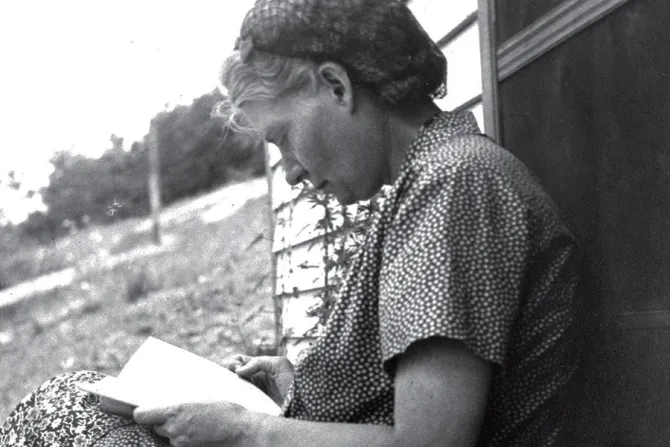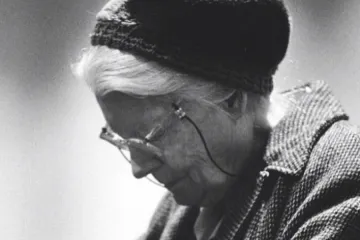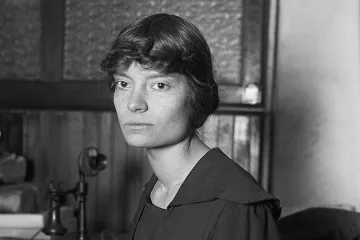New York City, N.Y., Dec 10, 2021 / 18:00 pm
More than a dozen boxes containing evidence of Servant of God Dorothy Day’s reputation for holiness are on their way to the Vatican, after a Mass this week in New York City marked the end of two decades of diocesan work on Day’s sainthood cause.
Day, who died in New York City in 1980, was an advocate for the poor and the founder of the Catholic Worker movement. The Archdiocese of New York, with permission from St. John Paul II, opened her sainthood cause in 2000.
I hope you’ve heard of Servant of God Dorothy Day - and if not, let’s change that! She’s one of the radiant stars in Catholic America. Here’s my Homily from the Young Adult Holy Hour and Mass on Wednesday: https://t.co/vgyL3RopHX
— Cardinal Dolan (@CardinalDolan) December 10, 2021
Cardinal Timothy Dolan of New York celebrated the Mass on Dec. 8, during which 17 cardboard boxes containing papers and evidence in support of Day’s cause sat at the front of the church, tied shut with red ribbons.
The boxes will be presented to the Congregation for the Causes of Saints and to Pope Francis.
"Folks, you're witnessing history," Dolan said during his homily on the feast of the Immaculate Conception, calling Day a "radiant star" of "American sanctity."
The canonical inquiry on the life of Dorothy Day began in April 2016, and involved the interviewing of more than 50 eyewitnesses who knew Day personally; the reading of over 3,000 pages that she wrote for the Catholic Worker newspaper; and other evidence that was collected and examined to determine whether Day lived a life of heroic virtue.
Day was born in Brooklyn in 1897 and raised in Chicago. She was baptized Episcopalian at the age of 12 and displayed signs at a young age of possessing a deep religious sense, fasting and mortifying her body by sleeping on hardwood floors.
In the 1910s, Day dropped out of college and moved to New York, where she took a job as a reporter for the country's largest daily socialist paper, The Call. She moved in socialist and bohemian circles, and undertook a series of disastrous romances, one of which included an abortion that she later deeply regretted.
She eventually entered into a common-law marriage with Forster Batterham, an anarchist lover of nature and a staunch atheist. Day lived for years on the Lower East Side and Greenwich Village. She moved to Staten Island in the 1920s, where she raised her daughter Tamar.
Dolan acknowledged that Day lived a "far from a sinless life" at first; a life in which she detected an "emptiness." This search for meaning helped to lead her to Catholicism; she began praying the rosary and had her daughter baptized Catholic.
She was received into the Catholic Church in 1927 at Our Lady Help of Christians Church in the Staten Island neighborhood of Tottenville.
After Batterham left Day, she lived in New York City as a single mother. Her deep-rooted and long-standing concern for the poor resurfaced. Along with the eccentric French itinerant philosopher Peter Maurin, she founded the Catholic Worker Movement in 1933.
Living the Catholic notion of holy poverty and practicing works of mercy, the two started soup kitchens, self-sustaining farm communities and a daily newspaper. In the course of her 50 years working among the poor and marginalized, Day never took a salary.
Dolan noted that Day went to the National Shrine in Washington D.C. on Dec. 8, 1935, and prayed that she would come to know God's providential plan. She wanted to live a simple, communal life, similar to the apostles.
(Story continues below)
She advocated Catholic devotion and hospitality while also engaged in social action for the poor and for civil rights. Her social criticism often took a radical perspective on poverty, labor, capitalism, and war, while still drawing on Catholic social teaching.
Her legacy lives on today in some 185 Catholic Worker communities in the U.S. and around the globe. Some members of her communities have expressed worry about the time spent and cost of her canonization process, saying that the expense could be better used to aid the poor.
In addition, some have noted that Day herself, in some of her writings, resisted being labeled a saint. However, Robert Ellsberg, who edited the first published collection of Day’s diaries, has said he thinks Day believed “we [are] all called to be saints” and that what Day objected to was being put “on a pedestal.”






